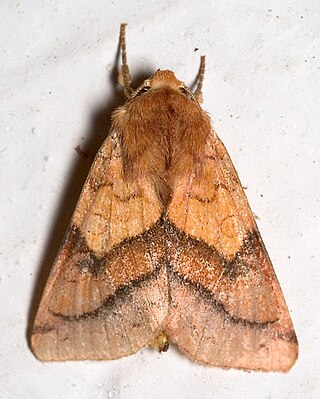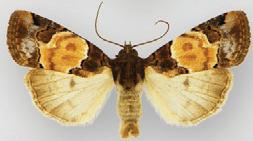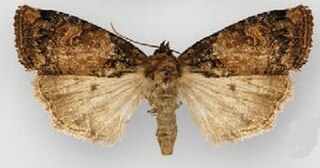
Euchloe ausonia, the eastern dappled white, is a southern European and Palearctic butterfly found mostly to the south and east of its almost indistinguishable relative the western dappled white.

Euxoa nigrofusca, the white-line dart, is a moth of the family Noctuidae. It is found from Europe, to southern Siberia, central Asia to the Pacific Ocean. In North Africa it is known from Morocco and Algeria.

Pseudohadena is a genus of moths of the family Noctuidae.

Agrotis fatidica is a moth of the family Noctuidae. It is found in Southern and Central Europe, east through Russia to Mongolia, China and Tibet.

Pyrrhia exprimens, the purple-lined sallow, is a moth of the family Noctuidae. The species was first described by Francis Walker (entomologist) in 1857. In North America it is found from Newfoundland and Labrador west across southern Canada to southern Vancouver Island, south to Texas, Arizona and California. Outside of North America it is found in Finland, the West Siberian plain, the South Siberian Mountains and Kazakhstan.

Bryolymnia viridata is a moth of the family Noctuidae first described by Leon F. Harvey in 1876. It is found in the US in western California from Sonoma County north of San Francisco southward to San Diego County.

Heliothis ononis, the flax bollworm, is a moth of the family Noctuidae. The species was first described by Michael Denis and Ignaz Schiffermüller in 1775. It is found in China, Kazakhstan, central Asia, northern Mongolia (Khangai), the Russian Far East, the Korean Peninsula, southern European part of Russia, southern and central Europe, southern and eastern Siberia and Turkey. In North America it is found from south-central Manitoba west to British Columbia, north to the Northwest Territories and Yukon and Alaska and south to Colorado.

Blepharita amica is a moth of the family Noctuidae. It is found from northern Europe to the Russian plain, the Ural, Siberia, the Amur Oblast, Primorye Region and Kazakhstan. It has also been recorded from the Korean Peninsula, Japan and north-eastern China.

Bryolymnia biformata is a moth of the family Noctuidae first described by Donald Lafontaine and J. Walsh in 2010. It is known only from the Huachuca, Patagonia, and Santa Rita Mountains in south-eastern Arizona.

Bryolymnia poasia is a moth of the family Noctuidae first described by William Schaus in 1911. It is found in Costa Rica.

Bryolymnia semifascia, the half-banded bryolymnia, is a moth of the family Noctuidae. The species was first described by John Bernhardt Smith in 1900. It is found in the US from northern Colorado and southern Utah southward to south-eastern Arizona and south-central New Mexico.

Bryolymnia ensina is a moth of the family Noctuidae first described by William Barnes in 1907. It occurs in coniferous forests from south-eastern Arizona and south-western New Mexico southward in the Sierra Madre Occidental to the state of Durango in Mexico.

The Erebidae are a family of moths in the superfamily Noctuoidea. The family is among the largest families of moths by species count and contains a wide variety of well-known macromoth groups. The family includes the underwings (Catocala); litter moths (Herminiinae); tiger, lichen, and wasp moths (Arctiinae); tussock moths (Lymantriinae), including the arctic woolly bear moth ; fruit-piercing moths ; micronoctuoid moths (Micronoctuini); snout moths (Hypeninae); and zales, though many of these common names can also refer to moths outside the Erebidae. Some of the erebid moths are called owlets.

Pseudohadena anatine is a moth of the family Noctuidae. It is found on the Ustyurt plateau in south-western Kazakhstan.

Pseudohadena evanida is a moth of the family Noctuidae. It is found in Central Asia, including Kazakhstan.

Pseudohadena magnitudinis is a moth of the family Noctuidae which is endemic to Iran.

Pseudohadena pseudamoena is a moth of the family Noctuidae. It is found in Armenia and Iran.

Austramathes pessota is a species of moth in the family Noctuidae. It is endemic to New Zealand and is found in Northland, in the southern North Island and in the South Island, mainly on the eastern side of that island but is also present in Fiordland. It is not regarded as being present in either Dunedin or the Southland district. This species lives in shrubland at altitudes ranging from sea-level up to subalpine. As at 2017, the larvae have yet to be described or photographed but it is known that they feed on Melicytus alpinus and it is likely that Melicytus micranthus is also a host. Adults of this species are distinctively patterned and coloured. Its appearance differs from its close relatives such as A. purpurea as it lacks the purple hue that can be seen on the latter species forewings. It also differs from A. coelacantha as it is much darker and has a distinctive small, round, pale mark on its forewing. Adults are on the wing from December to April.

Ichneutica cornuta is a moth of the family Noctuidae. This species is endemic to New Zealand and is only found in the South Island, in and around the Southern Alps. I. cornuta is very similar in appearance to pale forms of I. arotis. It is easy to confuse the two species as their ranges overlap. Male I. cornuta can be distinguished as it has longer pectinations on the antennae and the female lacks the dark scaling that can be found on the thorax of the I. arotis. There are also subtle differences in the forewing patterns of the two species. The life history of this species is unknown as are the host species of its larvae. Adults are on the wing from January to April.

Ichneutica inscripta is a moth of the family Noctuidae. This species is endemic to New Zealand. This species is found from south Auckland to Taranaki in the North Island. It prefers to inhabit dense native forest with high rainfall at higher altitudes. The life history of this species is unconfirmed as are the host species of its larvae but is likely to be similar to its close relative I. infensa. This species is very similar in appearance to its close relative I. infensa but has more strongly patterned forewings. The adults of this species are on the wing from late October to January.

















